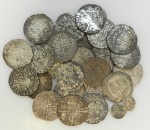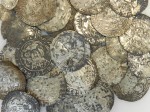 A medieval coin hoard was discovered January 28th, 2016, by metal detectorist Malcolm Shepherd in a field in the Beeston parish of Cheshire. He reported the find to the Portable Antiquities Scheme. Finds Liaison Officer Carl Savage examined the find and estimated based on the dates and types of coins that the hoard was deposited around 1498-1504.
A medieval coin hoard was discovered January 28th, 2016, by metal detectorist Malcolm Shepherd in a field in the Beeston parish of Cheshire. He reported the find to the Portable Antiquities Scheme. Finds Liaison Officer Carl Savage examined the find and estimated based on the dates and types of coins that the hoard was deposited around 1498-1504.
The hoard is composed of a select group of 26 coins: 9 silver groats of Edward IV, 14 silver groats of Henry VII, one  Edward IV penny, one Edward II farthing and one double patard of Charles the Bold of Burgundy. Silver groats were made of .925 fine silver, meaning they had a silver content of 92.5%, the sterling standard. This was a comparatively large denomination at the time of deposition. The owner deliberately picked silver-rich groats for hoarding, eschewing the smaller denominations that were in wide circulation.
Edward IV penny, one Edward II farthing and one double patard of Charles the Bold of Burgundy. Silver groats were made of .925 fine silver, meaning they had a silver content of 92.5%, the sterling standard. This was a comparatively large denomination at the time of deposition. The owner deliberately picked silver-rich groats for hoarding, eschewing the smaller denominations that were in wide circulation.
 One of the Edward IV groats, minted in 1480-83, held additional meaning to someone beyond its value as currency. It is perforated to the right of the crown at 2 o’clock on the coin face. That indicates the coin was worn as a pendant, as jewelry or maybe a good luck charm.
One of the Edward IV groats, minted in 1480-83, held additional meaning to someone beyond its value as currency. It is perforated to the right of the crown at 2 o’clock on the coin face. That indicates the coin was worn as a pendant, as jewelry or maybe a good luck charm.
 One penny and one farthing snuck in past the 24 higher denomination coins, and the Edward II farthing was worth collecting anyway because it was at least 190 years old when the hoard was buried. Those farthings turn up in hoards deposited as late as the early 1500s and are known to have remained in use in England until 1544 when all the silver coinage was taken out of circulation as part of King Henry VIII’s Great Debasement of the currency. Henry’s new debased coins were only 25% silver, meager indeed compared to the old groats.
One penny and one farthing snuck in past the 24 higher denomination coins, and the Edward II farthing was worth collecting anyway because it was at least 190 years old when the hoard was buried. Those farthings turn up in hoards deposited as late as the early 1500s and are known to have remained in use in England until 1544 when all the silver coinage was taken out of circulation as part of King Henry VIII’s Great Debasement of the currency. Henry’s new debased coins were only 25% silver, meager indeed compared to the old groats.
 One side-effect of the Great Debasement was that British coins were no longer accepted as currency in other countries because their precious metal content was so low. This had once been established policy, as evidenced by the double patard of Charles the Bold of Burgundy in the hoard. Edward IV and Charles the Bold signed a monetary alliance in 1469 which allowed English groats to circulate in the Burgundian Netherlands and Burgundian double patards (.878 silver content) to circulate in England. Double patards crop up fairly often in late Medieval English hoards, and three individual ones found in Cheshire are recorded in the Portable Antiquities Scheme database. They disappear from the English archaeological record after the 1530s, victims of the Great Debasement.
One side-effect of the Great Debasement was that British coins were no longer accepted as currency in other countries because their precious metal content was so low. This had once been established policy, as evidenced by the double patard of Charles the Bold of Burgundy in the hoard. Edward IV and Charles the Bold signed a monetary alliance in 1469 which allowed English groats to circulate in the Burgundian Netherlands and Burgundian double patards (.878 silver content) to circulate in England. Double patards crop up fairly often in late Medieval English hoards, and three individual ones found in Cheshire are recorded in the Portable Antiquities Scheme database. They disappear from the English archaeological record after the 1530s, victims of the Great Debasement.
 Last month, a coroner’s inquest determined that the Beeston Hoard qualified as treasure. Coins more than 300 years old with more than 10% precious metal content are classed as treasure, so assistant coroner Dr. Janet Napier’s decision was pretty much a foregone conclusion. As usual, per the terms of the Treasure Act, the next step is to assess the value of the coins which will be a kind of finder’s fee split between the finder and the landowner, to be raised by whichever institution wishes to acquire the hoard.
Last month, a coroner’s inquest determined that the Beeston Hoard qualified as treasure. Coins more than 300 years old with more than 10% precious metal content are classed as treasure, so assistant coroner Dr. Janet Napier’s decision was pretty much a foregone conclusion. As usual, per the terms of the Treasure Act, the next step is to assess the value of the coins which will be a kind of finder’s fee split between the finder and the landowner, to be raised by whichever institution wishes to acquire the hoard.